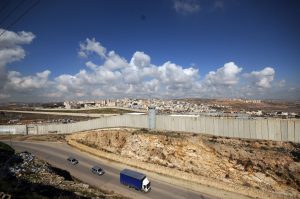In 1976, a report on Palestine declared, “The Palestinian people today face problems of formidable proportions.” That was the understatement of the century! Here we are, about to enter 2019, facing a daunting reality and an even more daunting future. One could say, The Palestinian people face problems of formidable proportions every day.
In the nitty-gritty of the here and now in Palestine, one is consumed by what seems to be a never-ending series of challenges brought about by our military occupier, Israel, and to a lesser degree, our governing body, the Palestinian government. Each is energized by a different set of motivations – Israel trying to make its military occupation a permanent fixture of our livelihood, and the Palestinian government trying to solidify its undemocratic grip on an increasingly volatile growing population – and the Palestinians living under occupation are being stretched to the limit. This does not even begin to address the state of affairs of Palestinians who live outside Palestine − the majority refugees − yearning to return home.
The infamous Declaration of Principles on Interim Self-Government Arrangements (aka Oslo Peace Accords) was scheduled to come to an end on May 4, 1999, five years after it was signed. This agreement was like fresh milk, it had an expiration date. Two decades later, we are still sipping this rancid milk. In hindsight, it seems that all stakeholders, except the military occupier, assumed that this interim arrangement would end with the realization of a Palestinian state, finally − albeit extremely delayed − recognizing the implementation of the two-state formula between Palestinians and Israelis.
History would have it otherwise.

Nevertheless, all tried their best to save the day, knowing deep inside that if this process did not work, what lay ahead was more than simply a bumpy road. In March 2000, Pope John Paul II did his part by making a historic visit to Israel and the Palestinian National Authority. This was followed by the Camp David Summit (July 11 to 25, 2000), which brought together United States President Bill Clinton, Israeli Prime Minister Ehud Barak, and PLO Chairman Yasser Arafat, but failed to reach an agreement.
The pope made a moving last-ditch attempt to bring humanity back into the equation, but an Israeli candidate for prime minister, Ariel Sharon, overshadowed any constructive attempts to remain positive. As part of his campaigning, Sharon was escorted by 1,000 Israeli police officers as he made a provocative visit to the site of the Dome of the Rock and Al-Aqsa Mosque in the Old City of Jerusalem on September 28, 2000. Sharon declared that the site would remain under perpetual Israeli control. For all intents and purposes, this visit, which provoked a violent response that culminated in what is now known as the second Intifada (compared to the mass movement of the first Intifada in 1987), destroyed any chances of salvaging the Oslo Peace Accords.
As the national Palestinian reality rapidly deteriorated, Palestinians felt that their compass was lost. Each person, each firm, and each sector did what it could to sustain the brunt of yet another downward spin out of control.
Resilience galore
The latest editions of This Week in Palestine (TWiP) are the best places to start to reflect on the foundations of steadfastness that have been the mainstay of the last two decades: Palestinian families, Palestinian teachers and, most importantly, Palestinian women − the unknown soldiers who comprise the unbreakable thread that holds together the quilt of society − all excelled in making sure that the community remained intact as everything around us collapsed. Palestinians with disabilities were not left behind in this exposé. Assisting in this effort was a mass of creativity – writers, performing artists, poets, and oral historians, as well as museums, cultural events, and the like. Even under the pressures of today, time and effort were found to address 70 years of the Nakba and 50 years of Israeli military occupation.
Not lost in the chatter of social media and noise of the daily news, Gaza was at the top of everyone’s agenda. Gaza pulled hard on our heartstrings as it endured onslaught after onslaught, making death and destruction so routine that even Palestinians found it hard to keep up. But Gaza was not, and is not, all about death and destruction. TWiP found the rays of light buried deep underneath the rubble to give the world, and us, a glance at Gaza the artist, Gaza the cook, Gaza the fisherman, Gaza the business, Gaza the future.
As the powers that be turned a blind eye to Palestinians in Israel, in the diaspora, and in Jerusalem, TWiP sounded multiple wake-up calls to direct the limelight onto the extraordinary achievements and steadfastness of Palestinians at home and around the globe. Our diplomatic corps who represent us and third states who assist us were all profiled too.

What sets TWiP apart is that it not only addresses our politics head on, unflinchingly presenting the voices of all walks of Palestinian life, it also goes beyond portraying us as political animals, lacking the full spectrum of humanity. Paging through 20 years of TWiP, you will find Palestinian sports, design, health, nature, wildlife, photography, and much more.
As the premier English publication dedicated to documenting Palestine, TWiP has surpassed everyone’s expectations. A free, high-quality, and professionally edited magazine is something we are all proud of. When the Israeli airport security apparatus interrogates a leading Jewish-American supporter of Israel on why he had in his possession an edition of TWiP, we smile because we know that such an act of nonviolent resistance is one that the military giant Israel has no clue how to deal with. It is no wonder that Israeli military forces raided the offices of TWiP in 2014, confiscating their computers that, to this day, remain in the occupation’s possession.
Looking forward
After all this recent history and with the entry of Donald Trump as America’s Commander in Collapse, Palestinians are being quizzed daily on their support for a solution to the conflict built on a model of one state or two states, as if these were menu items at a restaurant where our appetite at the moment should guide our choice. Real politics are not based on knee-jerk reactions produced on a fanciful whim.
The “black and white” view of one or two states is self-defeating; the fact is, restricting the dialogue to such territorial issues that focus on the form of statehood crowds out our primary need: rights. We should not abandon our call for and progress toward statehood, as if such issues were push-button-driven, and call for one state, which in today’s mindset in Israel is a full-scale, permanent apartheid state. Until Palestinian national sovereignty is realized, we demand to be dealt with as equal subjects under Israeli rule, the only sovereign entity that exists today between the sea and the river. Simultaneously, we should not shy away from aligning ourselves with the defined and internationally acclaimed political endgame of two states.
We must get political. Palestinian civil society, in conjunction with international civil society, must build the necessary alliances to bring Palestinian rights to the forefront of the international agenda. Today, we have no choice but to accept the apartheid one-state reality that we are forced to live in, and keep the two-state door open, while simultaneously bringing the issue of rights to the forefront of our demands. Our strongest ally is international civil society, but we cannot stop at civil society; it would be stopping short of effecting change. Instead we must leverage the widespread support of civil society in all corners of the world to get states to act, politically and otherwise, to support our just and internationally aligned struggle for freedom and independence.
If Palestinians’ rights continue to be denied and Palestinian statehood continues to be ignored by the powers that be, the risk is that Palestinians will redefine their self-determination away from statehood altogether and convert the struggle to one of civil rights alone; at that point, the game is over – even if the struggle for full civil rights lasts another fifty years. One day, Jewish Israelis and Jews around the world could find themselves gazing at the erstwhile “Jewish State” and admiring (in spite of themselves) Israel’s new, grand, pluralistic incarnation, while perhaps wondering nostalgically why they failed to encourage the emergence of an independent State of Palestine when they had the chance. Meanwhile, for the Palestinians to realize a path forward, a Palestinian-led international campaign is needed, leveraging support across the globe, to pressure the Israeli government into making its choice by a clearly defined deadline: ending the occupation, or equal treatment of all subjects under its control until a political solution is found.
All analysis aside, I can guarantee you this: Palestinians will not collectively vanish. We are here to stay, forever. Similarly, This Week in Palestine will surely be here to document our existence, our resistance, and our resilience.


